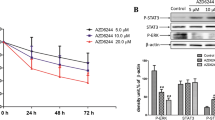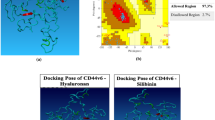Abstract
Biglycan (BGN) is overexpressed in cancer stem cells of colon cancer and induces the activation of NF-κB pathway which contributes to the chemotherapy resistance of diverse cancer types. Therefore, we hypothesized that the overexpression of BGN also promoted the development of multiple drug resistance (MDR) in colon cancer via NF-κB pathway. The expression of BGN was bilaterally modulated in colon cancer cell lines HT-29 and SW-480 and the effect of treatments on the cell proliferation and resistance to 5-FU was assessed. Moreover, the role of NF-κB signaling in the BGN-mediated formation of MDR was further investigated by subjecting BGN-overexpressed SW-480 cells to the co-treatment of chemo-agents and NF-κB inhibitor, PDTC. The inhibition of BGN expression decreased the proliferation potential of HT-29 cells while the induction of BGN expression increased the potential of SW-480 cells. BGN knockdown increased HT-29 cells’ sensitivity to 5-FU, represented by the lower colony number and higher apoptotic rate. To the contrary, BGN overexpression promoted the resistance of SW-480 cells to 5-FU. The effect of BGN modulation on colon cancer cells was associated with the changes in apoptosis and NF-κB pathways: BGN inhibition increased the expressions of pro-apoptosis indicators and suppressed NF-κB pathway activity while BGN overexpression had the opposite effect. It was also found that the BGN-mediated formation of MDR was impaired when NF-κB pathway was blocked. Findings outlined in the current study showed that BGN contributed to the formation of chemotherapy resistance in colon cancer cells by activating NF-κB signaling.





Similar content being viewed by others
References
Gill S, Thomas RR, Goldberg RM (2003) Review article: colorectal cancer chemotherapy. Aliment Pharmacol Ther 18:683–692
Hu T, Fei Li L, Shen J, Zhang L, Hin Cho C (2015) Chronic inflammation and colorectal cancer: the role of vascular endothelial growth factor. Curr Pharm Des 21(21):2960–2967
Li LF, Chan RLY, Lu L, Shen J, Zhang L, Wu WKK, Wang L, Hu T, Li MX, Cho CH (2014) Cigarette smoking and gastrointestinal diseases: the causal relationship and underlying molecular mechanisms. Int J Mol Med 34(2):372–380
Center MM, Jemal A, Smith RA, Ward E (2009) Worldwide variations in colorectal cancer. CA 59(6):366–378
Cunningham D, Atkin W, Lenz HJ, Lynch HT, Minsky B, Nordlinger B, Starling N (2010) Colorectal cancer. Lancet 375:1030–1047
Jemal A, Siegel R, Xu J, Ward E (2010) Cancer statistics, 2010. CA 60(5):277–300
Van Cutsem EJ (2008) Advanced colorectal cancer: ESMO clinical recommendations for diagnosis, treatment and follow-up. Ann Oncol 19(2):21–22
Dallas NA, Xia L, Fan F, Gray MJ, Gaur P, Buren GV, Samuel S, Kim MP, Lim SJ, Ellis LM (2009) Chemoresistant colorectal cancer cells, the cancer stem cell phenotype, and increased sensitivity to insulin-like growth factor-I receptor inhibition. Cancer Res 69(5):1951
Thomas H, Coley HM (2003) Overcoming multidrug resistance in cancer: an update on the clinical strategy of inhibiting p-glycoprotein. Cancer Control 10(2):159
Ong CW, Kim LG, Kong HH, Low LY, Iacopetta B, Soong R, Salto-Tellez M (2010) CD133 expression predicts for non-response to chemotherapy in colorectal cancer. Mod Pathol 23(3):450–457
Ward RJ, Dirks PB (2007) Cancer stem cells: at the headwaters of tumor development. Annu Rev Pathol 2(2):175–189
Ricci-Vitiani L, Lombardi DG, Pilozzi E, Biffoni M, Todaro M, Peschle C, De Maria R (2007) Identification and expansion of human colon-cancer-initiating cells. Nature 445(7123):111–115
Fang DD, Kim YJ, Lee CN, Aggarwal S, McKinnon K, Mesmer D, Norton J, Birse CE, He T, Ruben SM (2010) Expansion of CD133 + colon cancer cultures retaining stem cell properties to enable cancer stem cell target discovery. Br J Cancer 102(8):1265–1275
Xing X, Gu X, Ma T, Ye H (2015) Biglycan up-regulated vascular endothelial growth factor (VEGF) expression and promoted angiogenesis in colon cancer. Tumor Biol 36(3):1773–1780
Xing X, Gu X, Ma T (2015) Knockdown of biglycan expression by RNA interference inhibits the proliferation and invasion of, and induces apoptosis in, the HCT116 colon cancer cell line. Mol Med Rep 12(5):7538–7544
Frantz C, Stewart KM, Weaver VM (2010) The extracellular matrix at a glance. J Cell Sci 123(24):4195–4200
Pan S, Cheng L, White JT, Lu W, Utleg AG, Yan X, Urban ND, Drescher CW, Hood L, Lin B (2009) Quantitative proteomics analysis integrated with microarray data reveals that extracellular matrix proteins, catenins, and p53 binding protein 1 are important for chemotherapy response in ovarian cancers. OMICS 13(4):345–354
Mintz MB, Sowers R, Brown KM, Hilmer SC, Mazza B, Huvos AG, Meyers PA, LaFleur B, McDonough WS, Henry MM (2005) An expression signature classifies chemotherapy-resistant pediatric osteosarcoma. Cancer Res 65(5):1748–1754
Song R, Ao L, Zhao K-s, Zheng D, Venardos N, Fullerton DA, Meng X (2014) Soluble biglycan induces the production of ICAM-1 and MCP-1 in human aortic valve interstitial cells through TLR2/4 and the ERK1/2 pathway. Inflamm Res 63(9):703–710
Rajamannan NM (2006) Calcific aortic stenosis: a disease ready for prime time. Circulation 114(19):2007
Li F, Sethi G (2010) Targeting transcription factor NF-κB to overcome chemoresistance and radioresistance in cancer therapy. BBA-Rev Cancer 1805(2):167–180
Sakamoto K, Maeda S (2010) Targeting NF-κB for colorectal cancer. Expert Opin Ther Targets 14(6):593–601
Sui H, Zhou LH, Zhang YL, Huang JP, Liu X, Ji Q, Fu XL, Wen HT, Chen ZS, Deng WL (2016) Evodiamine suppresses ABCG2 mediated drug resistance by inhibiting p50/p65 NF-κB pathway in colorectal cancer. J Cell Biochem 117(6):1471–1481
Dick JE (2009) Looking ahead in cancer stem cell research. Nat Biotechnol 27(1):44–46
Yamamoto K, Ohga N, Hida Y, Maishi N, Kawamoto T, Kitayama K, Akiyama K, Osawa T, Kondoh M, Matsuda K (2012) Biglycan is a specific marker and an autocrine angiogenic factor of tumour endothelial cells. Br J Cancer 106(6):1214–1223
Westermann D, Mersmann J, Melchior A, Freudenberger T, Petrik C, Schaefer L, Lüllmann-Rauch R, Lettau O, Jacoby C, Schrader J (2008) Biglycan is required for adaptive remodeling after myocardial infarction. Circulation 117(10):1269–1276
Babelova A, Moreth K, Tsalastra-Greul W, Zeng-Brouwers J, Eickelberg O, Young MF, Bruckner P, Pfeilschifter J, Schaefer RM, Gröne H-J (2009) Biglycan, a danger signal that activates the NLRP3 inflammasome via toll-like and P2X receptors. J Biol Chem 284(36):24035–24048
Mohan H, Krumbholz M, Sharma R, Eisele S, Junker A, Sixt M, Newcombe J, Wekerle H, Hohlfeld R, Lassmann H (2010) Extracellular matrix in multiple sclerosis lesions: fibrillar collagens, biglycan and decorin are upregulated and associated with infiltrating immune cells. Brain Pathol 20(5):966–975
Song R, Zeng Q, Ao L, Jessica AY, Cleveland JC, Zhao K-s, Fullerton DA, Meng X (2012) Biglycan induces the expression of osteogenic factors in human aortic valve interstitial cells via Toll-like receptor-2. Arterioscler Thromb Vasc Biol 32(11):2711–2720
Shatz M, Menendez D, Resnick MA (2012) The human TLR innate immune gene family is differentially influenced by DNA stress and p53 status in cancer cells. Cancer Res 72(16):3948
Korneev KV, Atretkhany KN, Drutskaya MS, Grivennikov SI, Kuprash DV, Nedospasov SA (2017) TLR-signaling and proinflammatory cytokines as drivers of tumorigenesis. Cytokine 89:127
Acknowledgements
This study was supported by Grants from the Foundation of Department of Science and Technology, Liaoning Province (No. 2015020254) and the Wu Jieping Medical Foundation (No. 320.6750.17250).
Author information
Authors and Affiliations
Corresponding author
Ethics declarations
Conflict of interest
The authors disclose no conflict of interests.
Electronic supplementary material
Below is the link to the electronic supplementary material.
Rights and permissions
About this article
Cite this article
Liu, B., Xu, T., Xu, X. et al. Biglycan promotes the chemotherapy resistance of colon cancer by activating NF-κB signal transduction. Mol Cell Biochem 449, 285–294 (2018). https://doi.org/10.1007/s11010-018-3365-1
Received:
Accepted:
Published:
Issue Date:
DOI: https://doi.org/10.1007/s11010-018-3365-1




